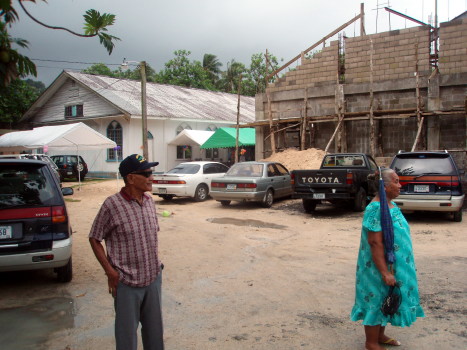
Tafunsak church east 0910
Every fourth year the Kosraens gather at one church and every community marches and sings brand new songs of praise. The day starts early, with morning service at 09:00 in the morning. Tafunsak had hoped to complete their new church ahead of marching. Had the new church been completed, this would have a been a third consecutive quadrennial marching in a new church - Malem in their new church 1999, Utwe in their new church 2003. At least one marching group had to calve off two marching wings, one left and one right, to fit into the church.

Tafunsak church east 0910
There was little to no room for spectators inside the church, most were seated under tents outside along the sides, with the North being a narrow alley between the existing church and the new church.
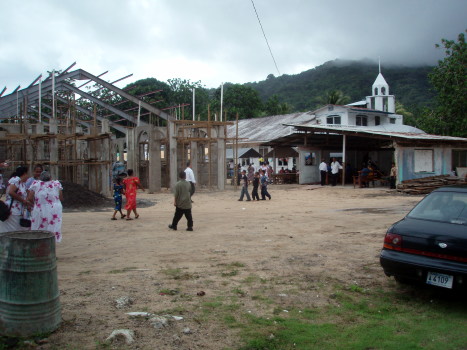
Tafunsak church west
Luanne Charley, on Guam during the fall of 2007, marched with first-draw opener Guam.
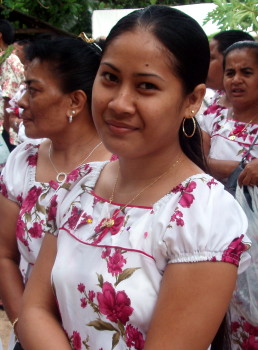
Luanne Charley
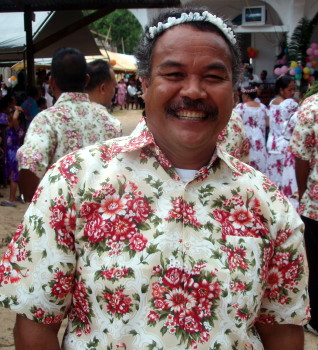
Wiggins Sigrah in the men's shirt for Guam
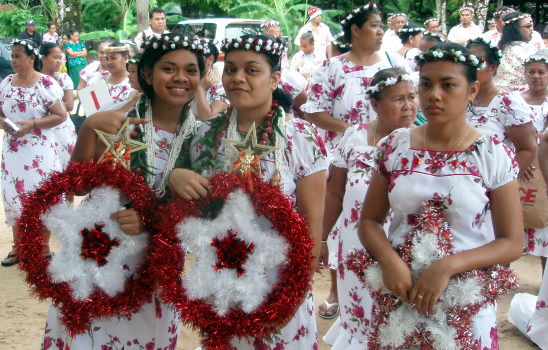
The lead stars for Guam
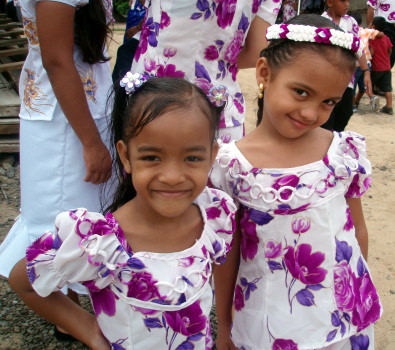
Serapein riamen from Pohnpei ready to march with Pohnpei in the second marching slot. Dresses by Shrue.
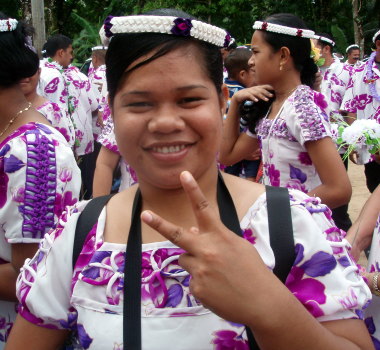
Beverlyn Nena
Beverlyn Nena displays a handmade mwarmwar made by the women of Pwudoi, Pohnpei under the guidance of Elise Ioanis Saimon. Getting a group ready for a quadrennial march pulls on the full resources of the home-away-from-home. Each group is looking for that unique and new look that no other group can bring or could possibly bring. The choir leader for Pohnpei is an experienced march designer brought in from Malem in Kosrae.
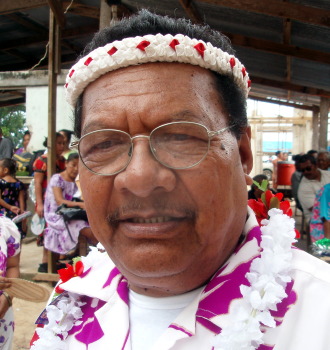
Choir leader
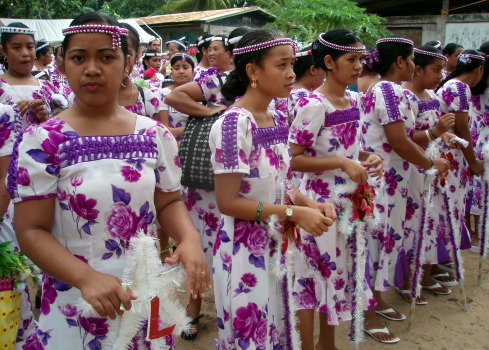
Evelyn Steiner (Ann-Margareth Siba)
Students at the College of Micronesia-FSM joined the Pohnpei delegation
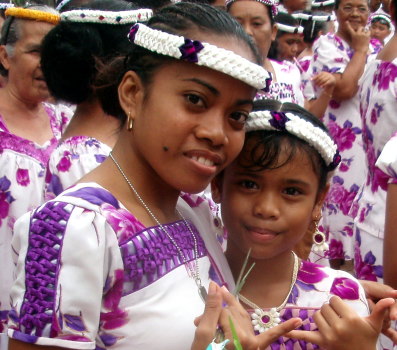
Leesen Albert
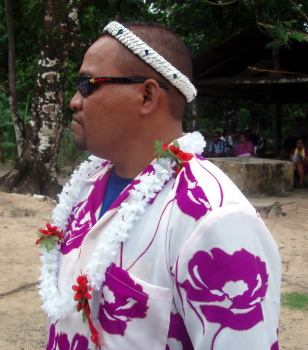
Rimski, Kosraen warrior ready for the heat of song

Part of Pohnpei's 14-span front star line. Two lead stars, six stars right and left.
Note that the lead stars wear dresses with special ornamentation, additional flourishes that add hours of labor to each custom one-off dress. There is honor in being a star, and there is a behind the scenes social competition to be a star. Being a lead star is uniquely special. Stars are almost always younger, unmarried women. The mothers and older women, who are often the stronger voices of the female sections, are usually found at the back of four or eight person marching units, each led by a star. In-between tend to be younger marchers or those who might not have made it to all the practices. In Kosraen marching, you only have to follow your star.
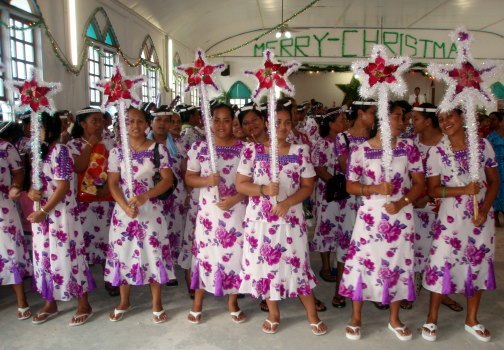
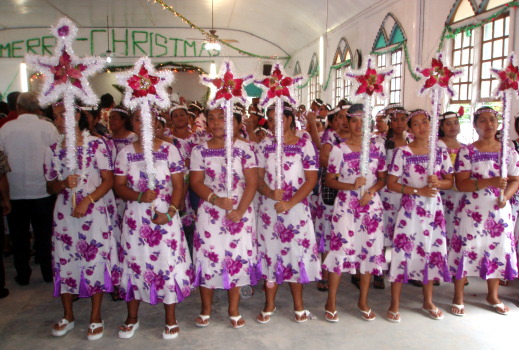
Pohnpei's front line at pel in sang
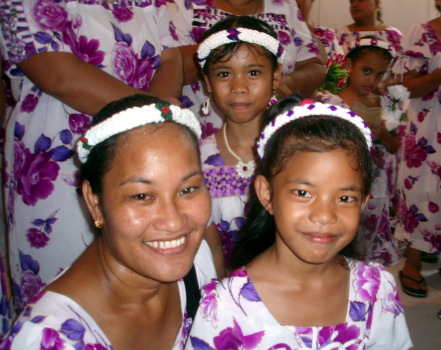
Smiling marchers
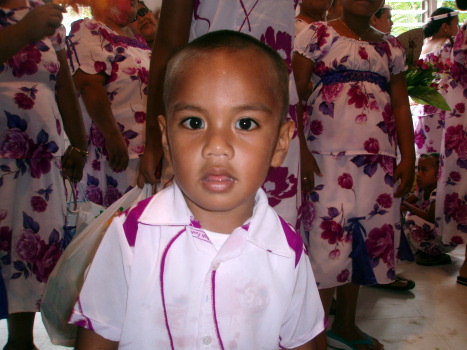
Next generation marcher
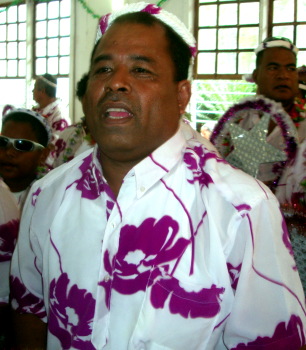
Josaiah Waguk
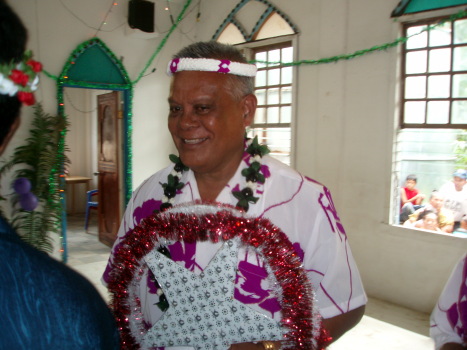
Pastor Mena of Malem joins Pohnpei.
Lacking a pastor of its own in 2007, the Pohnpei congregation was sponsored by Malem. Malem acted as the formal host for the Pohnpei delegation on Kosrae. In the spirit of the day, Reverend dons a shirt and joins in the festivities.
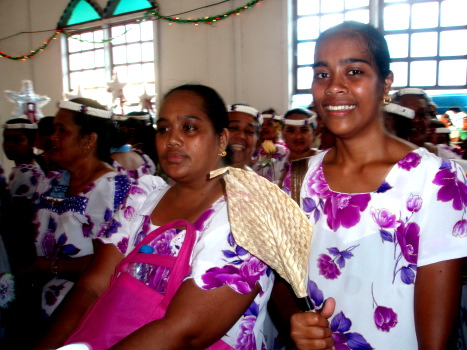
Shrue and Hannah Kilafwasru, Hannah pinch singing for a Pohnpeian regular singer who went out on reserve due to illness.
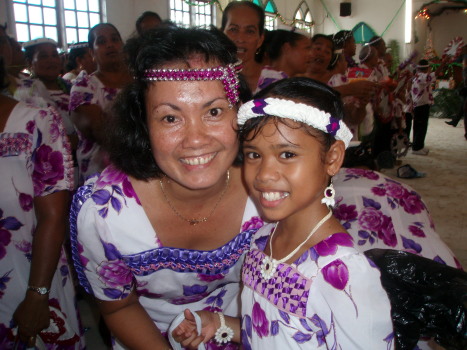
Emliana Segal. The glow is from the sweltering heat inside the church.
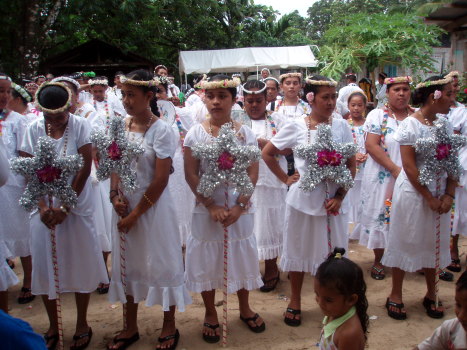
Kona, the fastest growing Kosraen community abroad, went third with the massive support of Lelu ichikumi.
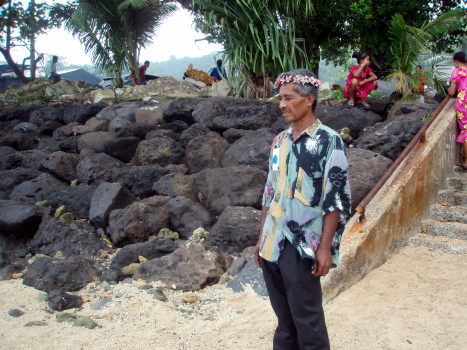
Bruce on the beach
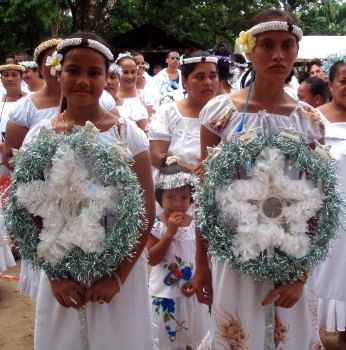
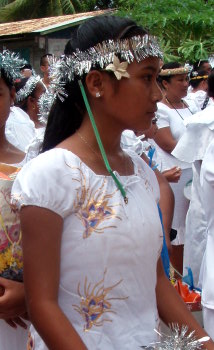
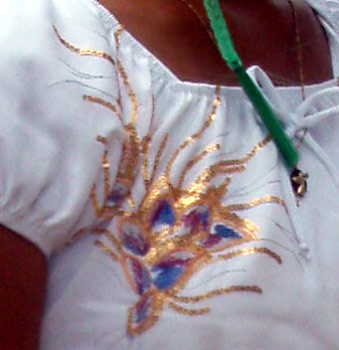
Seattle, with a fabulous fabric choice for their singing outfits. Definitely the must-have dress.
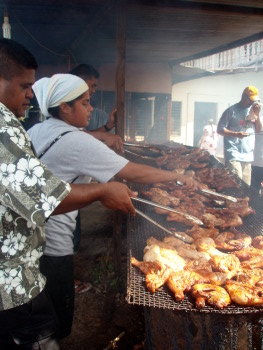
Barbecue production line
Feeding the troops on deployment required full mobilization of Tafunsak's food mustering capacity. All around the church food was being prepared. The largest operation occupied a location along the shore across the street.

Marshall Islands, primarily Ebeye marchers, with unique monetary necklaces and mwarmwars. The Marshall Island, due in part to Bikini compensation payments and Kwajalein rentals, has a lot more money to throw around than the Federated States of Micronesia. The FSM has more land, and the only high islands, but the eastern sister is wealthier.
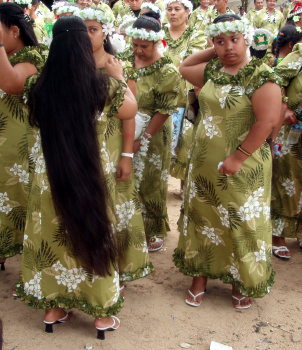
The Honolulu front line readies
If Ebeye is "old money" then the nouveau riche is Honolulu. Styled in the tradition of the Hawaiian muumuu using a wonderful Hawaiian floral pattern, the Hawaiian-Kosraens wore matching store bought mwarmwars.
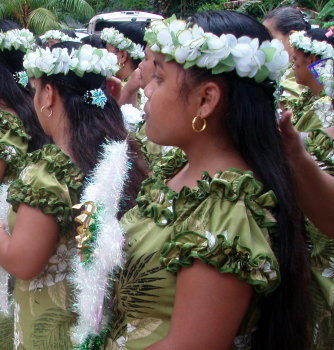
Wahine profile
The Kosraen wahine wore muumuus with the same intense attention to detail and handmade labor. The dresses flowed as they marched, hair down, Gauguinesque visions of loveliness.
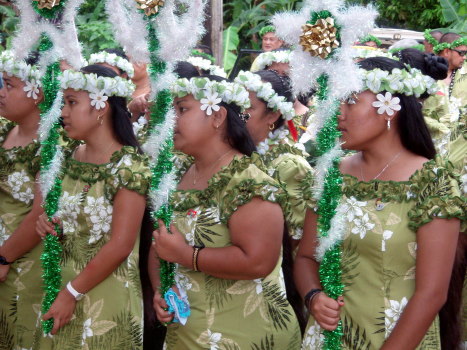
Honolulu brings their stars up
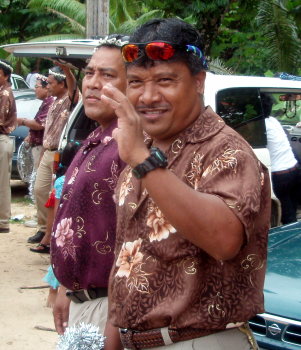
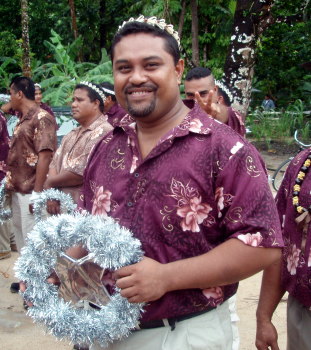
Skipper Ittu and Andy George in the shirts of the Malem men
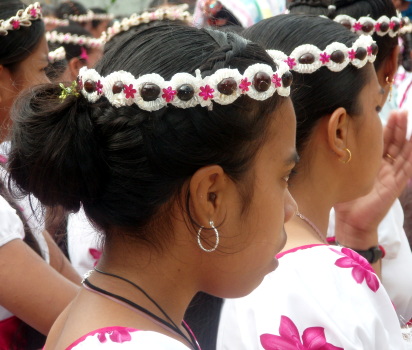
The mwarmwars of Malem
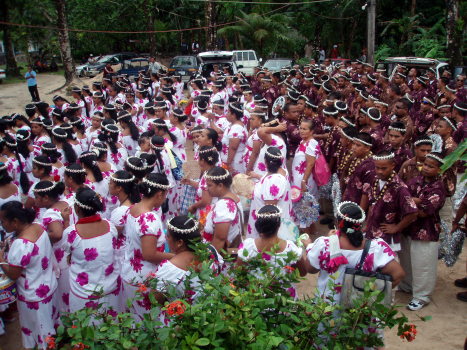
Etawi fusr Malem is a home island choir
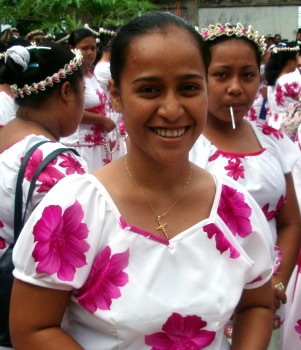
Eleanor Palik Talley
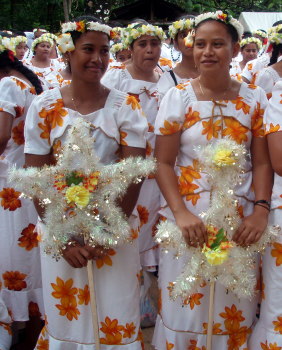
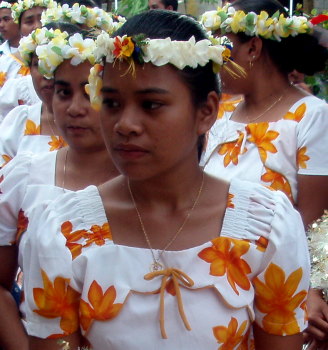
Lelu lead stars. A marcher looking pensive ahead the performance.
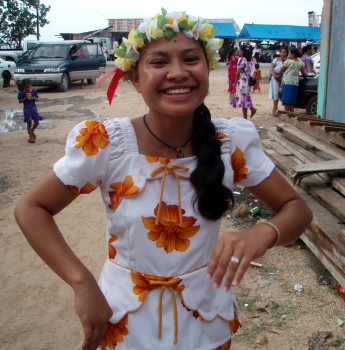
Mamerlyn Tosie ready to do song.
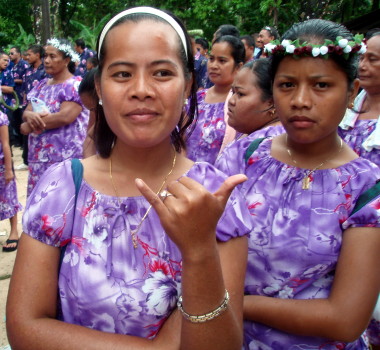
Maurine Albert marches with Walung
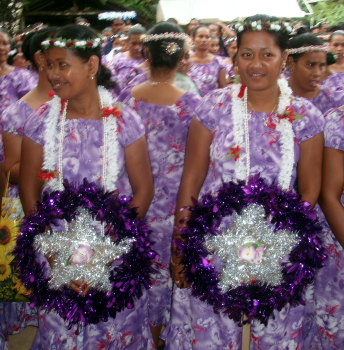
Walung lead stars
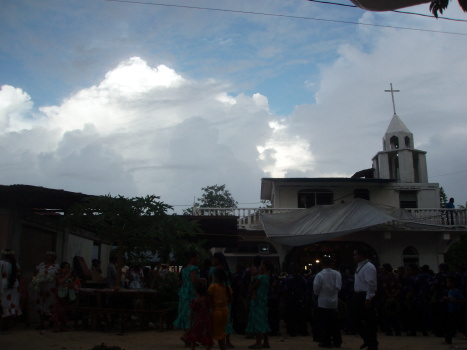
Rainclouds appear to the east. Within fifteen minutes a hard rain fell and delays the Utwean launch.
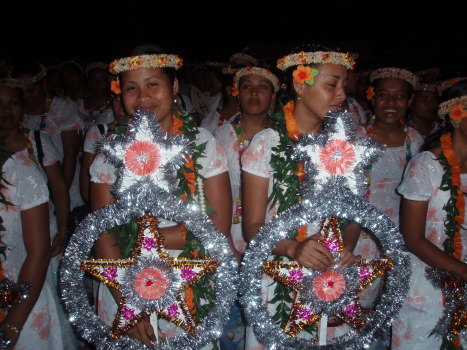
With the rain breaking up, the Utwe lead stars are ready to roll at 18:24 in the evening.
Day is done and the marching rolls on without a break. Many off-island Kosraens are also joining their home village choir. As the day pushes into its tenth hour, a few singers march with a third choir, racking up over three hours of marching and singing. The heat and humidity in the small church is unsafe for anyone but the heat acclimated distance runner. One woman is carried out after fainting. Warriors that sing, and leave no member behind. The day is emotional and intense in a way few ever appreciate. When in doubt, fall into step, march forth, and sing. A few choirs include Peace Corps volunteers from their villages.
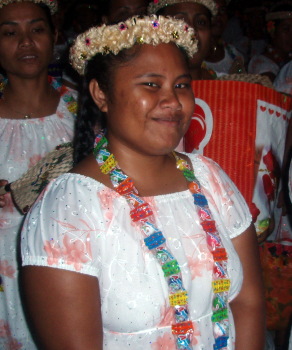
Utwe front right lead star
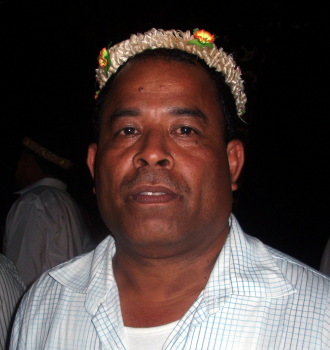
Josaiah Waguk on the Utwe line, at a minimum his second choir of the day.

The lead stars burst into the packed congregation with a thunderous sound rising behind them.
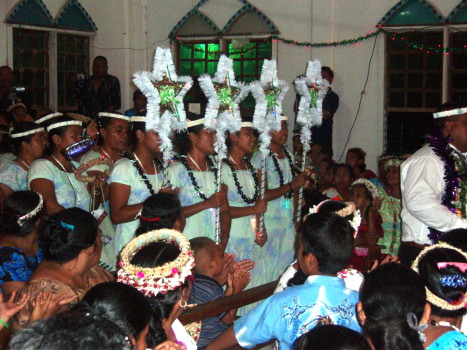
Tafunsak wing stars march in at 20:16 at night.
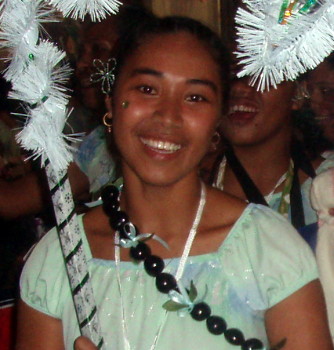
Carsina Taulung is a star, still holding forth two full hours later.

Tafunsak stars
The men wield five-pointed stars circumscribed inside a circle. The unit is called a tefuroh and is usually moved in unison left-right in front of the body. On a bell cue, often a double-bell ring, the men raise the tefuroh overhead and twist or move the tefuroh fore and aft above their heads. The Tafunsak men adopted a distinctively aggressive downward thrust movement accompanied by equally unusual whoops that punctuated a particular chorus. They also used an unusual single-handed parry motion with the tefuroh. There was no mistaking the body language, the vocalizations, and tefuroh motions. Warriors who move and think as one, a formidable force.
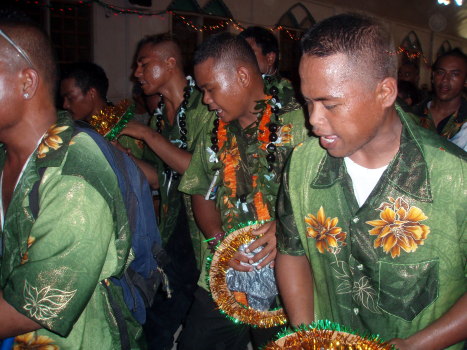
Tafunsak men on the downstroke with their tefuroh
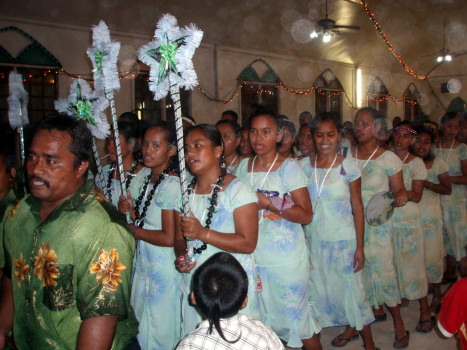
Dust fills the air as Tafunsak exits at 22:13, over eleven hours after morning service start.
The table below contains data gathered during the Utwe gathering of 2003 and the Tafunsak gathering of 2004. The recent fiscal difficulties for Kosrae state has accelerated the rate at which young Kosraens seek work abroad.
| Location | 2003 Conservative | 2003 Possible | 2007 | Growth |
|---|---|---|---|---|
| Ebeye | - | - | 30 | - |
| Guam | 200 | 300 | 300 | 50% |
| Honolulu | 600 | 1000 | 1000 | 67% |
| Kona | 200 | 200 | 800 | 300% |
| Maui | 100 | 100 | 60 | -40% |
| Pohnpei | 200 | 200 | 300 | 50% |
| Seattle | 200 | 200 | 600 | 200% |
| Texas | 200 | 200 | N/A | - |
| Virgina Beach | 200 | 200 | N/A | - |
| USA Other | - | 200 | N/A | - |
| Diaspora sums: | 1700 | 2400 | 3090 | - |
| Kosrae | 7663 | 7663 | 8183 | - |
| Est. Total Pop.: | 9363 | 10063 | 11273 | - |
| Percentage abroad: | 18.2% | 23.8% | 27% | 48% |
Ebeye: Ebeye is a remnant community that is aging. The legacy of marriages de facto arranged by missionaries at the Mwot school in the 1950s and 1960s between young Marshallese men and Kosraen women at the school, this community was represented by a group whose plurality was Marshallese. This community will all but disappear with time. The marching group was substantially reduced from four years ago.
Guam: The community on Guam appears fairly stable in numbers, but this belies that Guam is a waypoint for Kosraens on their way further abroad. Young Kosraens come and go with some frequency. There is an older core community that is working to acquire land for a meeting house. Kosraens have a good work reputation on Guam. One Guam-based Kosraen noted that returning home is fiscally all but impossible. The trip this year for him and his family cost six thousand dollars round-trip. The quadrennial gathering will decrease in its effectiveness for surveying diaspora population estimates as costs continue to rise.
Honolulu: Honolulu is the most difficult for which to get accurate numbers. There are at least 600 Kosraens on Oahu and probably closer to 1000 Kosraen-born Kosraens. There may be double that number with children born in Hawaii. At this point 1000 Kosraens in the Honolulu diaspora is a conservative estimate. The church there is now configured into three groups, West Side, Waikiki, and Kapiolani. This is the first multi-group church abroad of which I am aware. The community in Honolulu is extraordinarily diverse. Tourist industry labor, military personnel, students in schools there, medical referrals on long-term care stay, long term settled residents including many Kosraen-American and Kosraen-Hawaiian marriages. Typical of the complexity is a Hawaiian of Chinese ancestry who is married to a Kosraen and living on Kosrae who now has a daughter in school in Honolulu. She has returned "home" as much as she has left "home."
Kona: Kona reports 400 to 500 active church members and as many as a 1000 in the community . While 1000 may seem like a lot, that 50% of a diaspora is church active anecdotally appears to be a reasonable estimate. The principle employer are resorts in Kona, principally Four Seasons. Kosraens have a good reputation as employees on the Kona coast. The new deacon for Kona, Ben, concurred that tourism management degrees would be a real plus for Kosraens headed to Kona. Employment rates appear to be fairly high, and only ten Kosraens could return to Kosrae due to the cost and
Seattle: Seattle reports a large community of around 600 Kosraens, with roughly four arriving every week. That puts growth at about 200 per year. My informant, Senyorina's brother, works as a guidance counselor and is often a first point of contact for newly arriving Kosraens. Kosraens have a good work reputation, the only issues that arise are those of timeliness and absenteeism. The community is strong and supportive.
Kosrae: Current population estimate from Federated States of Micronesia Statistics Unit using their 2008 population estimate for Kosrae. The percent increase in Kosraens abroad was calculated against the more conservative numbers from 2003 as the "2003 possible" numbers were guesstimates of possible maximal values by Kosraens from those areas.